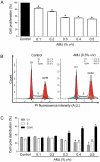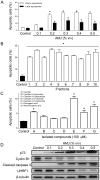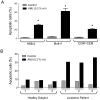Aronia melanocarpa juice induces a redox-sensitive p73-related caspase 3-dependent apoptosis in human leukemia cells
- PMID: 22412883
- PMCID: PMC3297612
- DOI: 10.1371/journal.pone.0032526
Aronia melanocarpa juice induces a redox-sensitive p73-related caspase 3-dependent apoptosis in human leukemia cells
Abstract
Polyphenols are natural compounds widely present in fruits and vegetables, which have antimutagenic and anticancer properties. The aim of the present study was to determine the anticancer effect of a polyphenol-rich Aronia melanocarpa juice (AMJ) containing 7.15 g/L of polyphenols in the acute lymphoblastic leukemia Jurkat cell line, and, if so, to clarify the underlying mechanism and to identify the active polyphenols involved. AMJ inhibited cell proliferation, which was associated with cell cycle arrest in G(2)/M phase, and caused the induction of apoptosis. These effects were associated with an upregulation of the expression of tumor suppressor p73 and active caspase 3, and a downregulation of the expression of cyclin B1 and the epigenetic integrator UHRF1. AMJ significantly increased the formation of reactive oxygen species (ROS), decreased the mitochondrial membrane potential and caused the release of cytochrome c into the cytoplasm. Treatment with intracellular ROS scavengers prevented the AMJ-induced apoptosis and upregulation of the expression of p73 and active caspase 3. The fractionation of the AMJ and the use of identified isolated compounds indicated that the anticancer activity was associated predominantly with chlorogenic acids, some cyanidin glycosides, and derivatives of quercetin. AMJ treatment also induced apoptosis of different human lymphoblastic leukemia cells (HSB-2, Molt-4 and CCRF-CEM). In addition, AMJ exerted a strong pro-apoptotic effect in human primary lymphoblastic leukemia cells but not in human normal primary T-lymphocytes. Thus, the present findings indicate that AMJ exhibits strong anticancer activity through a redox-sensitive mechanism in the p53-deficient Jurkat cells and that this effect involves several types of polyphenols. They further suggest that AMJ has chemotherapeutic properties against acute lymphoblastic leukemia by selectively targeting lymphoblast-derived tumor cells.
Conflict of interest statement
Figures





References
-
- Surh YJ. Cancer chemoprevention with dietary phytochemicals. Nat Rev Cancer. 2003;3:768–780. - PubMed
-
- Chung FL, Schwartz J, Herzog CR, Yang YM. Tea and cancer prevention: studies in animals and humans. J Nutr. 2003;133:3268S–3274S. - PubMed
-
- Sharif T, Auger C, Alhosin M, Ebel C, Achour M, et al. Red wine polyphenols cause growth inhibition and apoptosis in acute lymphoblastic leukaemia cells by inducing a redox-sensitive up-regulation of p73 and down-regulation of UHRF1. Eur J Cancer. 2010;46:983–994. - PubMed
-
- Walter A, Etienne-Selloum N, Brasse D, Khallouf H, Bronner C, et al. Intake of grape-derived polyphenols reduces C26 tumor growth by inhibiting angiogenesis and inducing apoptosis. FASEB J. 2010;24:3360–3369. - PubMed
-
- Hakimuddin F, Paliyath G, Meckling K. Treatment of mcf-7 breast cancer cells with a red grape wine polyphenol fraction results in disruption of calcium homeostasis and cell cycle arrest causing selective cytotoxicity. J Agric Food Chem. 2006;54:7912–7923. - PubMed
Publication types
MeSH terms
Substances
LinkOut - more resources
Full Text Sources
Medical
Research Materials
Miscellaneous

